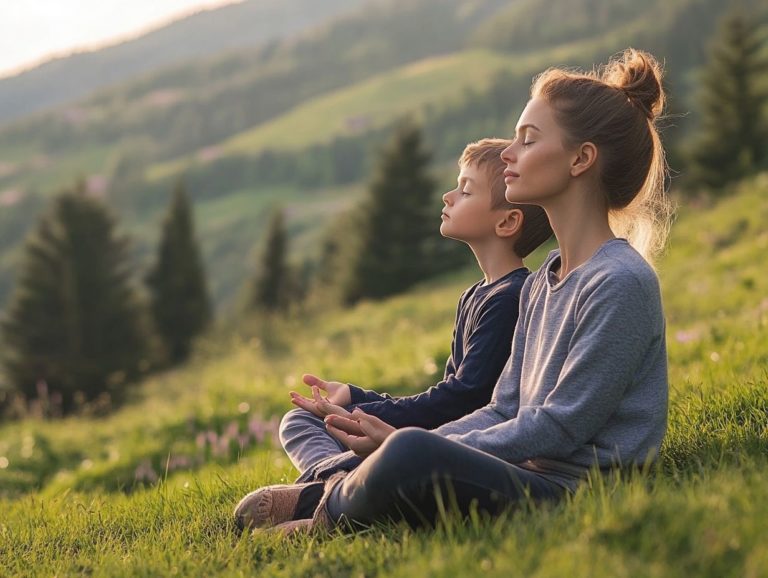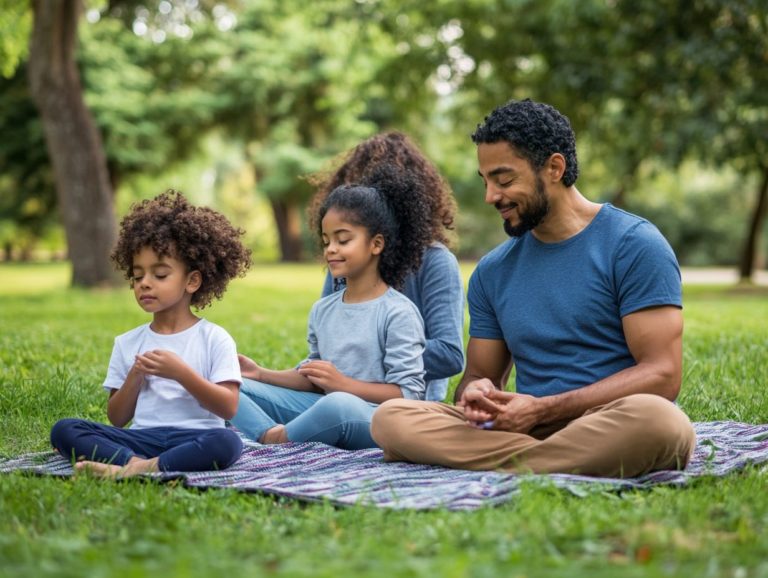How to Teach Mindfulness to Preschoolers
In today s fast-paced world, teaching mindfulness to preschoolers is becoming increasingly vital. This exploration delves into what mindfulness truly is and why it carries significant value for young children. It offers insights into mental health and self-compassion.
You’ll discover the myriad benefits of introducing mindfulness practices paired with engaging activities that transform learning into an enjoyable experience. From cultivating a calm environment to actively involving parents, this piece highlights best practices and strategies for overcoming potential challenges. These challenges include enhancing self-control and executive functions.
Join us in this exciting journey to foster emotional well-being and resilience in the little ones you care for.
Contents
- Mindfulness for Preschoolers: Benefits and Activities
- What are the Benefits of Teaching Mindfulness to Preschoolers?
- How to Introduce Mindfulness to Preschoolers?
- What are Some Fun and Engaging Activities for Teaching Mindfulness?
- How to Incorporate Mindfulness into Daily Routines?
- What are the Best Practices for Teaching Mindfulness to Preschoolers?
- How to Create a Safe and Calm Environment for Mindfulness Practice?
- Encouraging Participation in Mindfulness Activities
- Tips for Overcoming Resistance in Teaching Mindfulness
- How to Support and Reinforce Mindfulness in Preschoolers?
- Frequently Asked Questions
- Can mindfulness be taught to preschoolers?
- What are some benefits of teaching mindfulness to preschoolers?
- How do I introduce mindfulness to preschoolers?
- What are some mindfulness techniques suitable for preschoolers and kids?
- How often should I practice mindfulness with preschoolers and kids?
- What if a preschooler or kid has difficulty with mindfulness practices?
Key Takeaways:
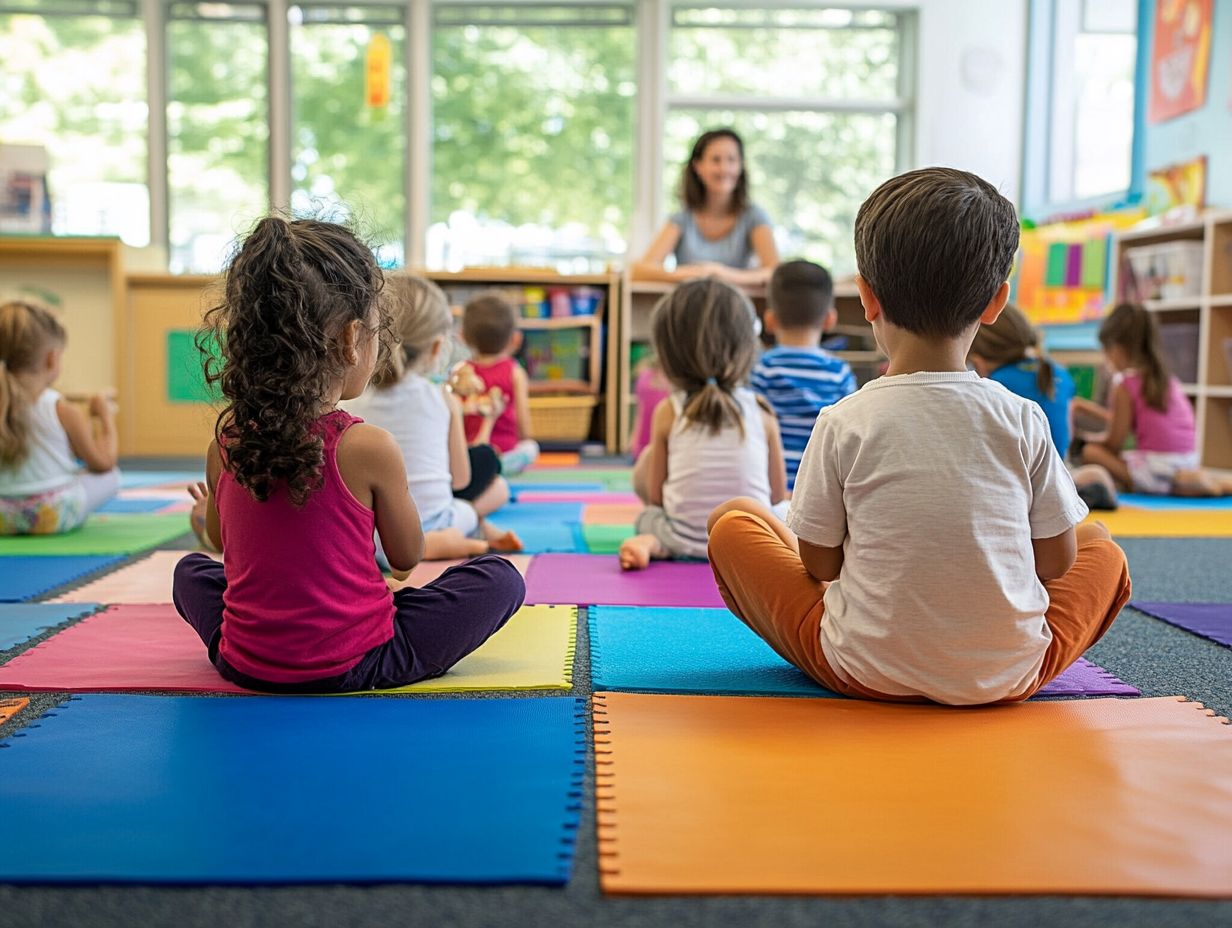
- Mindfulness is the practice of being present in the moment, benefiting preschoolers by promoting self-regulation, reducing stress, improving attention, and enhancing executive functions and social skills.
- Introduce mindfulness to preschoolers using fun activities such as breathing exercises, yoga, and sensory play. Incorporate it into daily routines like mealtime, nature walks, and transitions between activities. Mindful parenting can further support these practices.
- To effectively teach mindfulness, create a safe and calm environment, encourage participation, and address behavioral challenges. Involving parents and caregivers can reinforce mindfulness at home through guided practices and mindful breathing.
What is Mindfulness?
Mindfulness is the art of paying attention to what you feel and think right now. It invites you to be present and fully engaged in the here and now. This enables you to observe your inner experiences without judgment.
This practice can manifest in numerous ways such as meditation, mindful breathing, and various exercises designed to deepen your self-awareness and refine your emotional regulation. Incorporating relaxation techniques fosters a sense of calmness.
For preschoolers, mindfulness is a powerful tool to nurture resilience, enhance emotional intelligence, and instill a sense of calm amid life s challenges. These practices can also improve their mental health and emotional support systems.
Why is Mindfulness Important for Preschoolers?
Mindfulness holds special significance for preschoolers as it establishes a crucial foundation for emotional regulation. It enhances resilience and promotes overall well-being. In a world filled with stressors, mindfulness practices are invaluable tools for developing effective coping skills.
By incorporating mindfulness into daily routines, preschoolers can learn to navigate their feelings with compassion and kindness. This nurturing approach cultivates healthier relationships and sets the stage for improved academic performance and mental well-being as they grow.
Start practicing mindfulness with your preschoolers today to unlock their full potential!
Mindfulness for Preschoolers: Benefits and Activities
What are the Benefits of Teaching Mindfulness to Preschoolers?
Teaching mindfulness to preschoolers brings a wealth of advantages that significantly contribute to their emotional, cognitive, and social development. These benefits include enhanced emotional intelligence, improved attention spans, effective stress management, and increased self-compassion.
Mindfulness exercises help children recognize and regulate their emotions. This fosters resilience and equips them to cope with challenges. Mindfulness nurtures an appreciation for positive experiences and deepens their connections with themselves and others, ultimately enriching their overall well-being and quality of life.
Research shows that preschoolers who practice mindfulness tend to exhibit heightened emotional intelligence, becoming more skilled at identifying their own feelings and those of their peers. For instance, introducing simple breathing exercises can enable children to pause and reflect before reacting in challenging situations, paving the way for improved conflict resolution.
Studies indicate that mindfulness practices can also lead to longer attention spans. This allows these young learners to engage more deeply in their activities, thus reinforcing their capacity to concentrate. This increased attentiveness not only enhances their learning experience but also strengthens their relationships, as they become more present and empathetic with friends, fostering a supportive and cooperative atmosphere during play and collaborative tasks.
How to Introduce Mindfulness to Preschoolers?
Introducing mindfulness to preschoolers can be a truly delightful and enriching endeavor. It significantly enhances their emotional and cognitive development. You can achieve this through engaging family practices that seamlessly weave mindfulness activities into daily routines.
Begin by incorporating simple techniques like mindful breathing and sensory experiences that prompt children to become aware of their feelings and surroundings. By making mindfulness both enjoyable and accessible, you, as a parent or educator, can cultivate a sense of calm and appreciation for the present moment, ultimately nurturing their emotional intelligence and resilience.
What are Some Fun and Engaging Activities for Teaching Mindfulness?
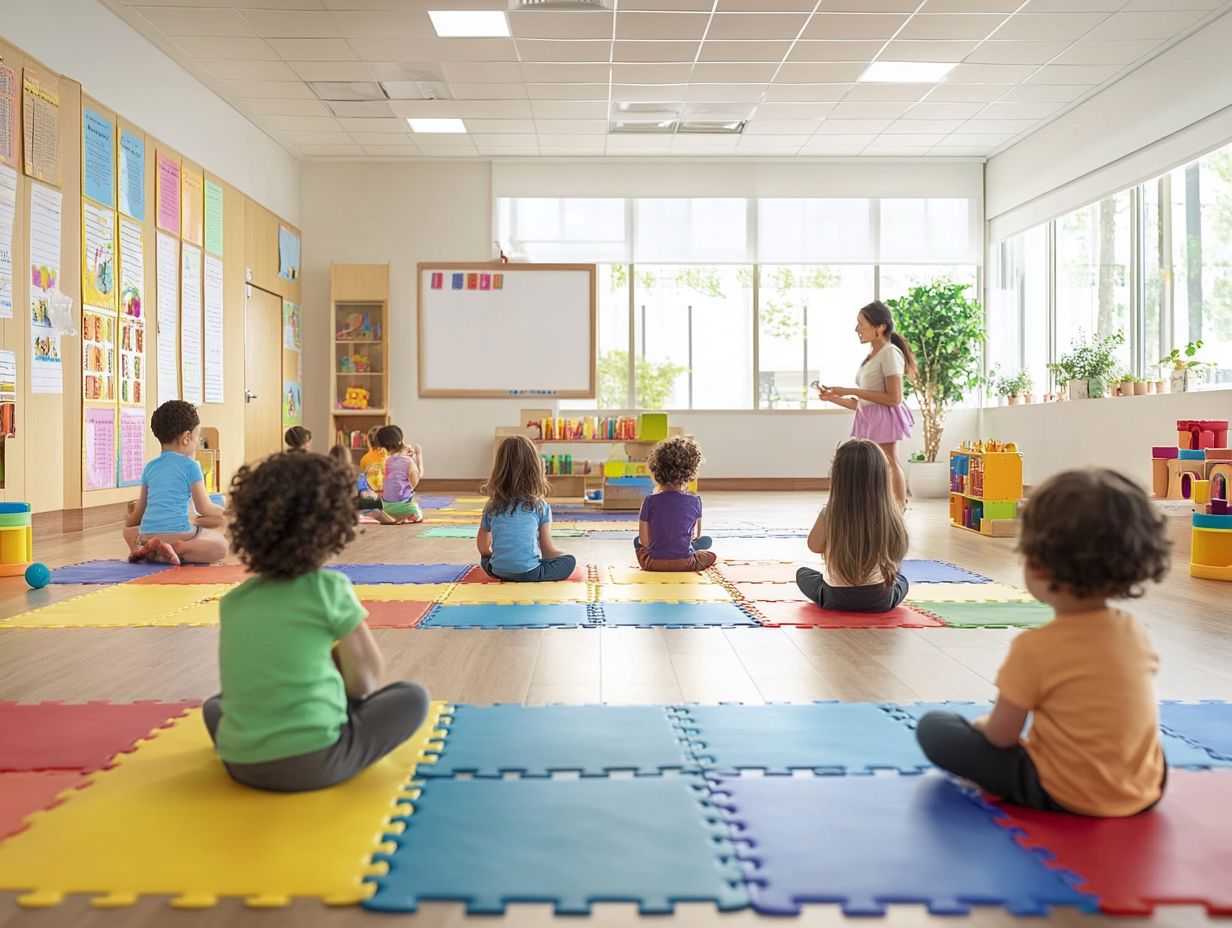
You can explore a wealth of fun and engaging activities designed to teach mindfulness to preschoolers, making this enriching practice both enjoyable and accessible. Consider incorporating mindful breathing games, sensory exploration, and nature walks to help children connect with their emotions and their surroundings. Family activities that include these practices can further enhance their impact.
These playful moments captivate their attention and nurture a genuine appreciation for the present moment and positive experiences. By weaving elements of fun into these activities, you enable children to actively engage in mindfulness practices, enhancing their focus and emotional regulation skills.
Think about simple yoga poses or storytelling that resonates with emotions. These activities cater to various learning styles and developmental stages. Guided practices and relaxation techniques can further support these activities.
For example, a mindful breathing game might involve blowing bubbles, where each bubble symbolizes a child’s worries drifting away, transforming potentially anxious moments into serene ones. Sensory exploration could include creating a nature collage, inviting little ones to gather leaves and flowers, thus fostering their awareness of the world around them.
Nature walks encourage preschoolers to notice the vibrant colors, sounds, and textures they encounter. This deepens their connection to their environment and their feelings.
Together, these interactive exercises lay a delightful foundation for young learners to cultivate essential mindfulness skills.
How to Incorporate Mindfulness into Daily Routines?
Incorporating mindfulness into your preschooler s daily routine can truly elevate their emotional awareness and overall well-being. Consider integrating simple practices like mindful breathing before meals, sharing gratitude during family time, or employing calming techniques at bedtime. Family practices like these create an enriching framework for mindfulness that is both accessible and impactful.
Establishing a consistent routine is crucial; it reinforces these mindfulness habits, allowing them to become an integral part of your child s life. You can amplify the benefits of these practices by engaging in mindfulness activities together as a family. Think about nature walks where you focus on the sights and sounds around you. Set aside quiet moments for reflection through storytelling. Incorporating attention to details during these activities can further deepen the mindfulness experience.
Creating a designated ‘mindfulness corner’ in your home can also be beneficial. Fill it with calming objects that encourage thoughtful engagement. By actively practicing and modeling these techniques, your family can cultivate an environment that not only cherishes mindfulness but also fosters emotional resilience, self-awareness (understanding one’s own emotions), and connection, ensuring your child develops these essential skills effectively.
What are the Best Practices for Teaching Mindfulness to Preschoolers?
The most effective practices for teaching mindfulness to preschoolers center on creating a friendly space that fosters emotional growth and resilience. This involves creating a calm and safe space for mindfulness activities, using language suited to their age, and modeling mindful behaviors yourself.
Incorporate positive reinforcement and encourage open communication to greatly enhance their engagement and willingness to participate in mindfulness practices. By prioritizing emotional support and nurturing a sense of connection, as well as focusing on well-being practices, you can teach mindfulness in a way that truly resonates with young learners.
How to Create a Safe and Calm Environment for Mindfulness Practice?
A safe and calm environment makes mindfulness practice exciting and enjoyable for preschoolers. Consider setting up a designated mindfulness space that is free from distractions, adorned with calming elements like soft lighting, comfortable seating, and nature-inspired decor. When children feel secure and relaxed, they are more likely to engage fully in mindfulness exercises. This enhances their emotional regulation and self-awareness. Establishing a routine around this practice can elevate their sense of calmness and focus.
To achieve this, think about incorporating soothing materials such as plush rugs and pillows where preschoolers can settle in comfortably. Gentle music or natural soundscapes can further enrich the atmosphere, making the space more inviting and enhancing their emotional well-being.
Integrating mindfulness tools like stress balls or fidget toys will aid in honing their attention and channeling their energy in a positive direction. Maintaining a consistent daily mindfulness routine reinforces feelings of safety and predictability, allowing preschoolers to approach each session with a peaceful mindset. Incorporating breathing techniques can also help reduce stress and improve focus during these sessions.
Over time, these thoughtful elements work in harmony to build a sense of community, encouraging children to explore their emotions and thoughts without fear. This sense of connection and awareness fosters self-control and emotional regulation, key components of their overall well-being.
Encouraging Participation in Mindfulness Activities
Encouraging participation and engagement in mindfulness activities among preschoolers requires a dash of creativity and a keen focus on their interests and playfulness. By weaving in storytelling, music, or movement, you can make mindfulness practices not only appealing but also relatable to young children.
Fostering open communication about feelings and experiences is essential for fun mindfulness activities! This connection will help them feel more eager to take part. Incorporating fun and interactive mindfulness exercises can also enhance their engagement.
When you make mindfulness activities fun and interactive, you deepen their understanding of the practice. This approach also boosts their emotional intelligence and resilience.
Use interactive games and visual aids to capture their attention. Transforming abstract concepts into tangible experiences is key. For example, using puppets or art supplies allows children to express their thoughts and feelings creatively, reinforcing the mindfulness techniques you re introducing.
These activities also promote self-awareness and appreciation for positive moments. Holding group discussions encourages them to share their insights and cultivates a supportive atmosphere.
This two-way communication builds trust and amplifies their enthusiasm for mindfulness practices. Tailoring the activities to reflect their personal experiences ensures your approaches resonate deeply with them, fostering a lasting interest in mindfulness that can blossom over time.
This approach enhances their ability to focus and improves their attention span.
Tips for Overcoming Resistance in Teaching Mindfulness
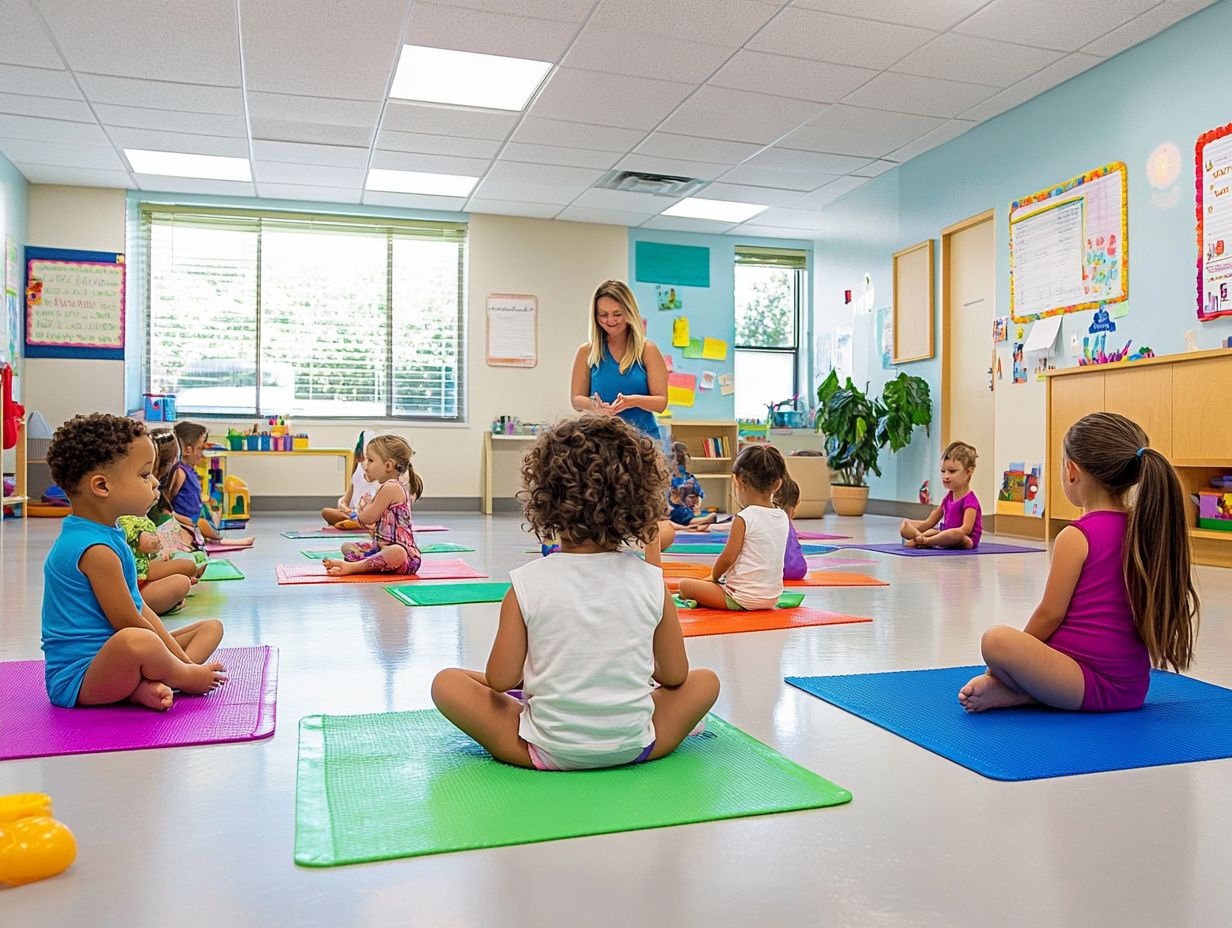
Navigating resistance or challenges when teaching mindfulness to preschoolers calls for both patience and a compassionate approach. Recognize that children might push back against mindfulness exercises, often due to their unfamiliarity or struggles with focus.
Offering emotional support, tailoring activities to suit their developmental level, and incorporating playful techniques can significantly reduce their resistance. By acknowledging their feelings and providing gentle encouragement, you can cultivate an environment that nurtures openness to mindfulness practices.
This ultimately promotes managing feelings in these young minds. Encouraging self-compassion and understanding their inner experiences further supports their journey.
How to Address Behavioral Issues During Mindfulness Practice
Addressing behavioral issues during mindfulness practice is essential to ensure a positive experience for preschoolers. Stay calm and patient, keeping in mind that children may struggle to focus or display restlessness during these exercises.
Implement calming techniques such as gentle guidance, redirection, or encouraging brief breaks to effectively manage these behaviors. Reinforcing the significance of managing feelings enables children to express their feelings appropriately and helps them develop better coping skills.
To foster a nurturing environment, introduce visual cues like colored cards or soft toys that signal when it s time to focus or take a moment to breathe. This creates a sense of structure and security, aiding their concentration.
Incorporating playful elements, such as breath-counting games or singing calming songs, engages preschoolers more effectively. As a parent or educator, modeling mindfulness behaviors by demonstrating calmness through your own practice provides children with tangible examples of emotional regulation and self-control.
These strategies enhance focus and help cultivate long-lasting skills that contribute to children’s overall emotional well-being and academic performance.
What are Some Strategies for Maintaining Consistency in Teaching Mindfulness?
Maintaining consistency in teaching mindfulness to preschoolers is essential for reinforcing its benefits and ensuring a lasting impact. By establishing a regular schedule for mindfulness practices, you can help children grasp its significance and seamlessly integrate it into their daily routines.
Incorporating mindfulness into family practices and everyday activities creates an environment rich in engagement and learning. Providing ongoing emotional support and celebrating small successes will further inspire children to embrace mindfulness as a regular part of their lives.
To achieve this, you might introduce simple breathing exercises during transitions or create mindful moments throughout the day, perhaps before meals or nap time. Encouraging families to share these practices at home fosters a supportive environment where shared mindfulness experiences can thrive. This approach can enhance their attention to details and overall mental health.
Storybooks that focus on mindfulness themes are also excellent tools for engaging both children and caregivers, driving discussions and reflections on the importance of being present. Additionally, you can offer workshops or resources to parents on how to weave mindfulness into everyday routines, reinforcing the practice in a holistic and impactful way.
How to Support and Reinforce Mindfulness in Preschoolers?
Supporting and nurturing mindfulness in preschoolers requires you to create an environment that fosters their emotional intelligence and enhances their overall well-being. You can achieve this through consistent practice, positive reinforcement, and open dialogues about feelings and experiences.
Engaging in mindfulness activities together as a family and encouraging your children to express their thoughts can deepen their understanding of mindfulness principles. Moreover, acknowledging and celebrating their progress will inspire them to embrace mindfulness as a lifelong practice. The practice of gratitude and appreciation for small moments can also enhance their emotional well-being.
How to Involve Parents and Caregivers in Mindfulness Practice?
Involving parents and caregivers in mindfulness practice is crucial for amplifying its benefits and ensuring a consistent approach in children s lives. Engaging in workshops, family mindfulness activities, and maintaining open lines of communication about mindfulness strategies can enable you to take an active role in your child’s mindfulness journey.
By fostering collaboration between educators and families, your children can experience mindfulness not only at school but also at home, enhancing their emotional regulation and resilience.
One effective way for you to engage with this process is by utilizing a resource kit filled with mindfulness exercises, age-appropriate books, and guides on integrating mindfulness into daily routines. Regular updates through newsletters or social media can keep you informed about the practices being taught in class, fostering a strong sense of community.
Imagine hosting family mindfulness days where you and your child can practice exercises together; this not only strengthens your bond but also solidifies the skills learned at school. Sharing mindfulness experiences creates an open dialogue, making it easier for your family to incorporate these techniques and cultivate a nurturing environment for your children’s overall well-being. This collaboration also enhances family relationships.
What are Some Ways to Incorporate Mindfulness into the Home Environment?
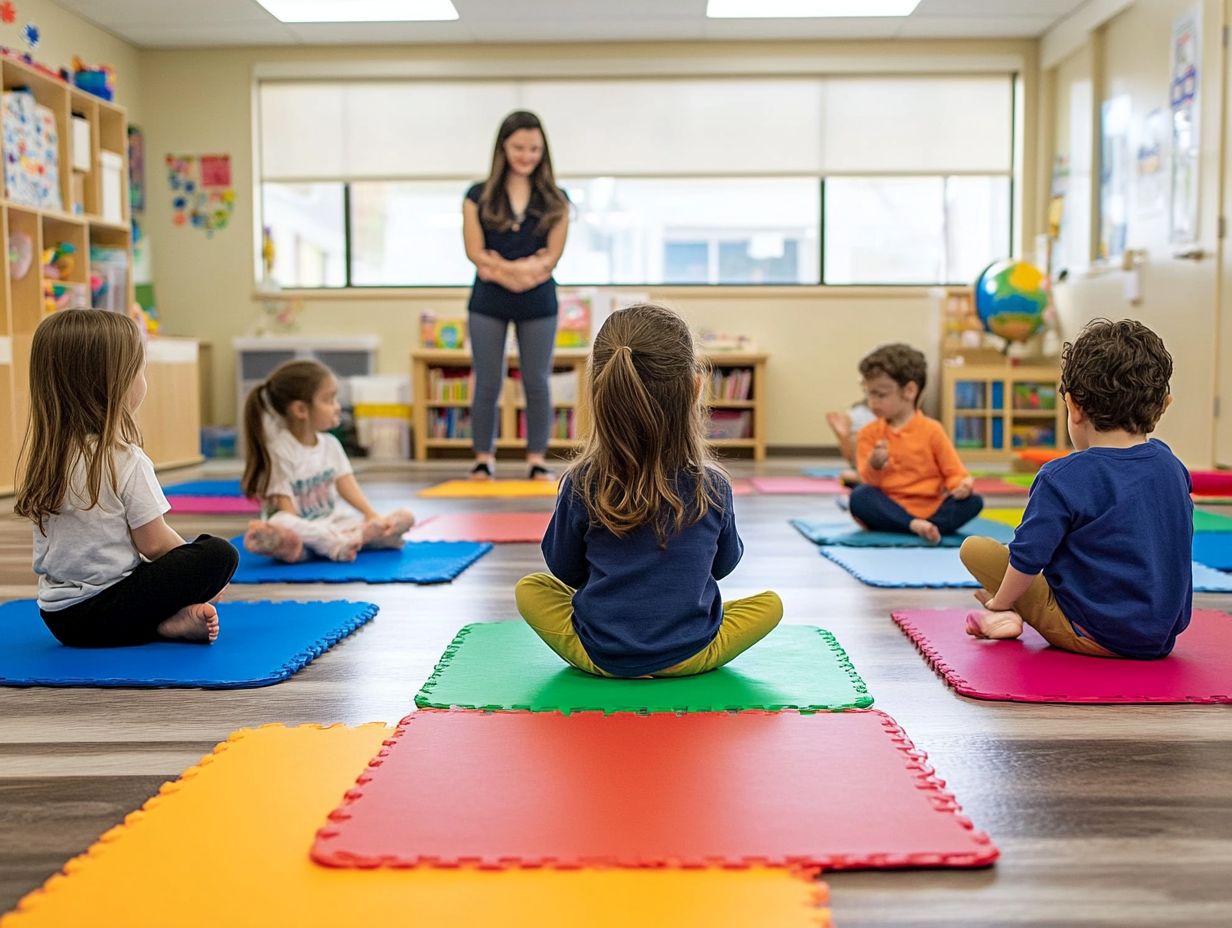
Incorporating mindfulness into your home environment for preschoolers can significantly enhance their emotional well-being and cultivate a culture of awareness. Think about creating a designated mindfulness corner filled with calming visuals, engaging in mindful breathing exercises before bedtime, or encouraging heartfelt gratitude discussions during meals.
These simple practices can seamlessly weave mindfulness into your daily family life. By making these activities accessible and enjoyable, you can nurture emotional regulation and resilience in your children.
Consider introducing sensory activities where your little ones can explore textures or embark on nature walks, allowing them to observe their surroundings mindfully. Establishing a routine that includes moments of silence for reflection or gentle yoga can create a soothing atmosphere and enhance inner experiences.
Utilizing resources like children’s books focused on mindfulness can offer engaging narratives that impart valuable lessons. With these thoughtful methods, you can transform ordinary moments into opportunities for mindfulness, helping your children forge a deeper connection with themselves and the world around them. These practices can also improve their overall mental health and appreciation for nature.
Frequently Asked Questions
Can mindfulness be taught to preschoolers?
Yes, mindfulness can be taught to preschoolers. Research has shown that children as young as 3 years old can learn and practice mindfulness techniques.
What are some benefits of teaching mindfulness to preschoolers?
Teaching mindfulness to preschoolers can help improve their attention and focus, reduce anxiety and stress, and promote emotional regulation and self-awareness. It also improves their thinking skills and overall mental health.
How do I introduce mindfulness to preschoolers?
Introduce mindfulness to preschoolers and kids by using simple and age-appropriate language, incorporating fun activities and games, and leading by example by practicing mindfulness yourself. Emphasize the importance of attention, emotions, and awareness to help them develop these skills.
What are some mindfulness techniques suitable for preschoolers and kids?
- Deep breathing exercises
- Body scans (paying attention to different parts of the body)
- Mindful coloring
- Guided meditation
- Other calming techniques
These mindfulness exercises can also help improve their focus and attention span.
How often should I practice mindfulness with preschoolers and kids?
It is recommended to practice mindfulness with preschoolers at least once a day, for a few minutes at a time. Consistency and repetition will help them develop the habit of mindfulness. Engaging in mindfulness activities as part of family practices can also strengthen familial connections and promote overall well-being.
What if a preschooler or kid has difficulty with mindfulness practices?
If a preschooler is having difficulty with mindfulness practices, try using a different technique or approach, such as sensory experiences or playful moments in nature. Keep the sessions short and engaging, and provide positive reinforcement and encouragement. Introducing elements like self-compassion, gratitude, and emotional support can also help improve their mindfulness practice.
Start today to see amazing results! Incorporate these mindfulness techniques into your daily routine and transform your home into a mindfulness haven.

